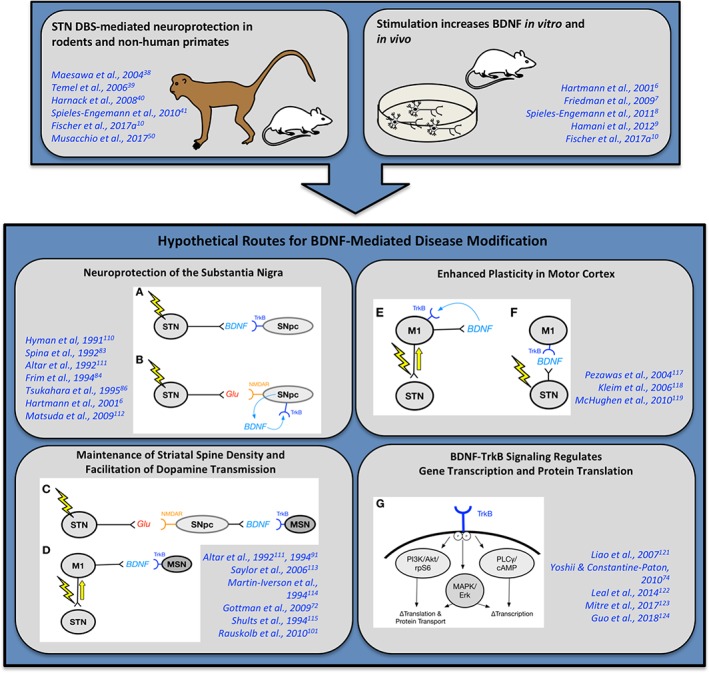Figure 3.

Hypothetical routes for BDNF‐mediated disease modification. Preclinical studies have demonstrated STN DBS‐mediated neuroprotection in rodents and nonhuman primates.10, 38, 39, 40, 41, 50 In addition, high‐frequency stimulation increases BDNF in vitro and in vivo.6, 7, 8, 9, 10 In light of these preclinical studies, there are several hypothetical routes for BDNF‐mediated disease modification. The SNpc may be protected directly (A,B).6, 83, 84, 86, 110, 111, 112 (A) DBS increases STN activity, increases activity‐dependent release of BDNF at the SNpc and binding to TrkB for a trophic effect. (B) DBS increases STN activity, increases glutamate (Glu) release at the SNpc and binding to NMDA receptors (NMDAR). SNpc activation results in production of BDNF transcript, translation, and local release of BDNF that binds to TrkB for an autocrine/paracrine trophic effect. BDNF may maintain striatal spine density and facilitate dopamine transmission (C,D).72, 91, 101, 111, 113, 114, 115 (C) DBS increases STN activity, increases glutamate (Glu) release at the SNpc and binding to NMDA receptors (NMDAR). SNpc activation results in production of BDNF transcript, translation, and activity‐dependent release of BDNF that binds to TrkB on striatal medium spiny neurons (MSNs) for a trophic effect, including maintenance of spine density. (D) DBS results in antidromic activation of corticosubthalamic projections from the motor cortex (M1)116 and subsequent activity‐dependent release of BDNF via corticostriatal fibers to bind to TrkB on MSNs for an ultimately trophic effect. BDNF may enhance M1 plasticity (E,F).117, 118, 119 (E) DBS results in antidromic activation of corticosubthalamic projections from the M1 and activity‐dependent release of BDNF by cortical neurons in an autocrine/paracrine manner, thereby enhancing plasticity. (F) DBS activates STN activity and through subthalamocortical projections found in the rat120 releases BDNF in the M1 and enhancing plasticity. Of importance, BDNF‐trkB signaling exerts powerful effects on intracellular signaling pathways (G).74, 121, 122, 123, 124 (G) Intraneuronal changes with some shown in the STN DBS paradigm specifically,10 where TrkB phosphorylation results in phosphorylation of Akt and ribosomal protein S6 (rpS6), as well as MAPK/Erk and PLCγ/cAMP signaling pathways that have been shown to result in changes in transcription, translation, and protein transport.
